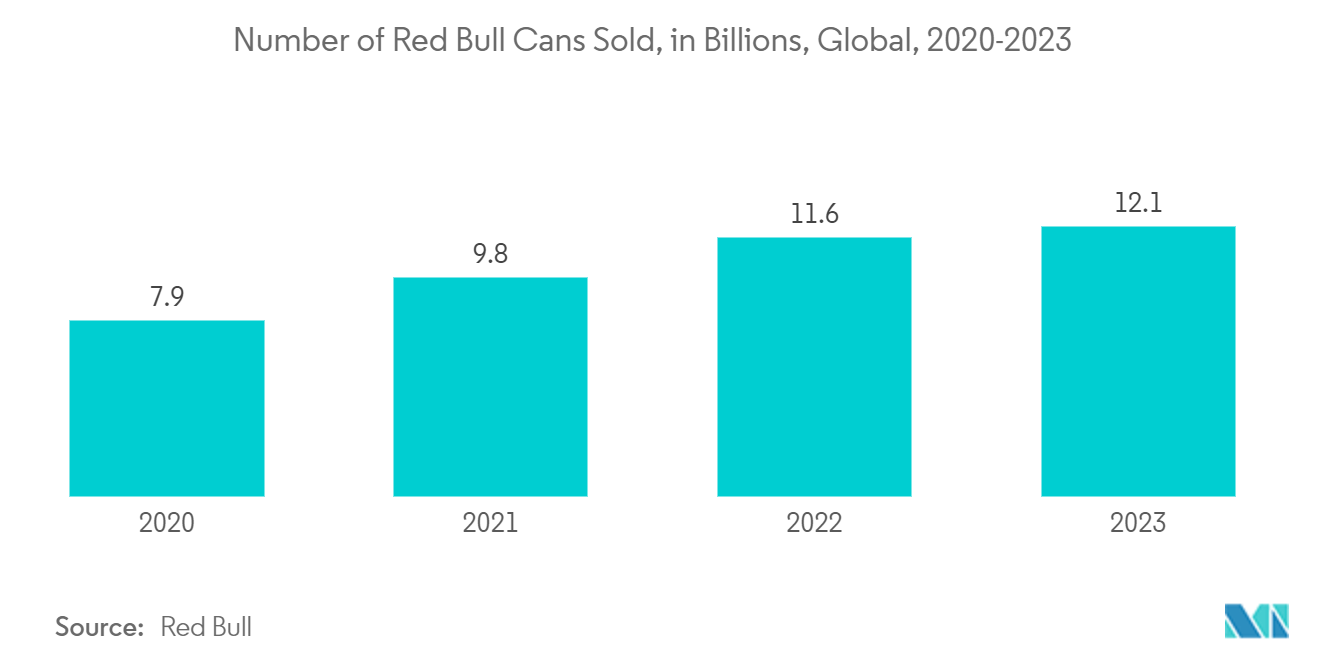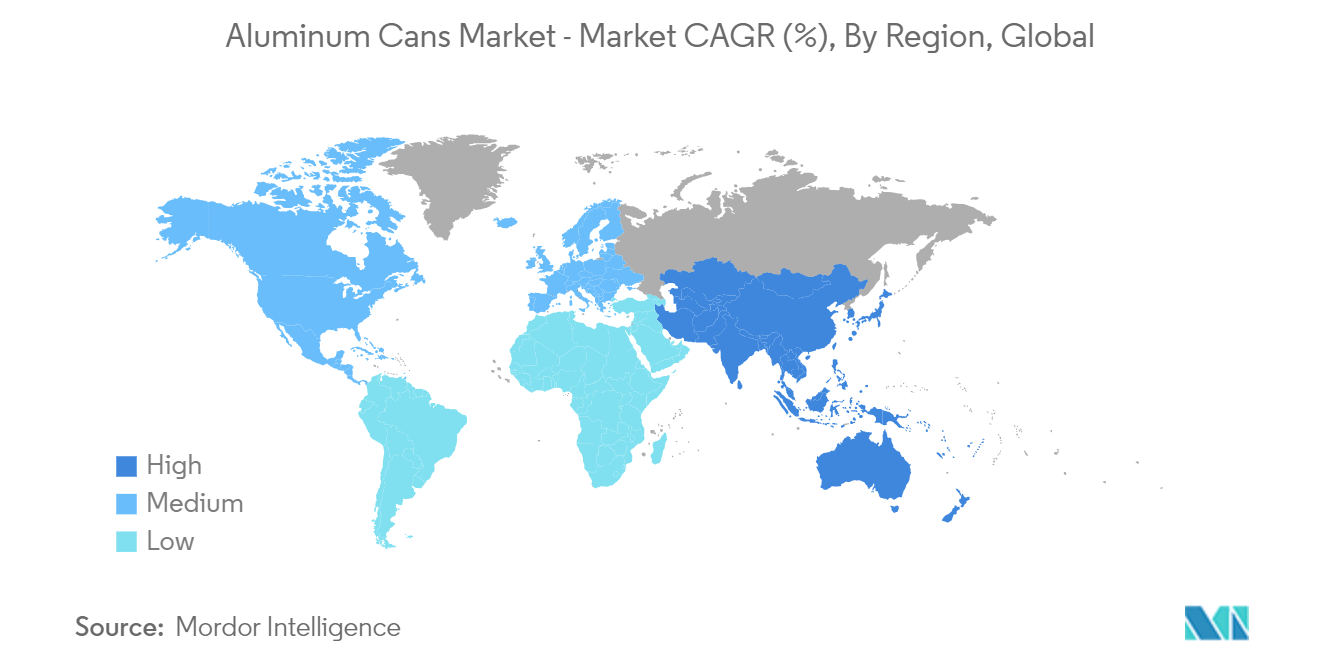Market Trends of Aluminum Cans Industry
Food and Beverages Segment to Drive the Market
- Younger populations and individual living consumers are consuming more canned food and beverages. These users have less time and are budget-restrained, thus opting for products with lower costs and higher convenience. Changing lifestyles in developing countries worldwide and the growing rate of urbanization are resulting in consumers opting for easy-to-cook food.
- Moreover, with the shrinking size of the family, along with the changing patterns in lifestyle, the declining amount of time spent on the preparation of meals and consumption at home is leading to the shift toward more processed, frozen, and pre-prepared foods in which canned foods are the most common form of packaging.
- Aluminum Cans are most widely used for beverages, with the most notable trend of canned wine, cocktails, hard beverages, and soft beverages being packaged in metal, driven by the need for portability in the market. The usage of metal cans in the beverage industry can be widely classified into alcoholic and non-alcoholic drinks based on the nature of the beverage. Alcoholic drinks, such as beer, have historically used metal cans, while other kinds of liquor, like wine, traditionally served in glass bottles, are increasingly adopting metal cans.
- Due to their portability and ease of use, cans are trendy among millennials and GenZ. Additionally, manufacturers are launching the product in can packaging because their design is popular with young people. For instance, 12.1 billion cans of Red Bull were sold worldwide in 2023. This represents an increase of 18.1%. From EUR 7.816 billion (USD 8.52 billion) to EUR 9.684 billion (USD 9.29 billion), group revenue increased by 23.9%.
- Aluminum cans are preferred for food packaging for various reasons, including heat-conductivity, hygiene, and safety, which has made it a convenient choice for the domestic and industrial sectors; owing to this, aluminum cans are widely used in the food industry for the packaging of meat and seafood, fruits and vegetables, ready meals, pet food, soups and condiments, and others. Such a broad end-user market creates significant demand for aluminum cans catering to the food industry. Also, aluminum is extensively used in food contact materials because aluminum-containing food contact materials are an anthropogenic source of dietary aluminum.
- Also, the focus on stockpiling food with long shelf life, owing to the change in consumer behavior as a result of the pandemic, has contributed to the rise in the usage of aluminum cans for packaging food and is expected to leave a long-lasting positive impact on the growth of the studied market. Canned fish sales have boomed since the lockdown period in Europe, particularly in fish-loving Southern European nations such as Spain, France, and Italy. According to Statistics Norway, the consumer price index (CPI) of canned fish in Norway increased in the past few years from 111.4 points in 2018 to 125.3 points in 2022.
- Initiatives by environmental groups and public awareness about the environment have increased awareness among users worldwide. Consumers are increasingly abandoning plastic usage, whereas the demand for recycled products is growing. As a result, it is creating a high demand for metal-packaged products, including aluminum cans.

North America to Hold a Significant Share in the Market
- North America holds the largest market share in revenue due to growing concerns regarding using and consuming sustainable packaging materials. It accounts for over one-third of the total global consumption of aluminum cans.
- There has been a steady growth in products such as sodas, energy drinks, sparkling waters, and, increasingly, craft brew beers. Aluminum cans are one of the most sustainable beverage packages and are infinitely recyclable. They also chill quickly, providing a superior metal canvas to print and, more importantly, protecting the flavor and integrity of your favorite beverages.
- Moreover, the demand for aerosol cans is anticipated to rise along with the personal care sector's expansion in the United States. The growth of the personal care business is primarily related to consumers' increased disposable income and ability to purchase luxury goods. Aerosols are utilized in several personal care products. Thus, the market is projected to profit from their rising sales.
- Additionally, the higher production demands of deodorants/antiperspirants led to the installation of an increasing number of production lines in North America over the past few years. North America accounts for a significant share of the market studied due to the increasing demand from the personal care segment, spanning products of various types, such as deodorants, antiperspirants, hair mousses, hair sprays, shaving mousses, etc. For instance, according to the US Census and Simmons National Consumer Survey (NHCS) data, 298.7 million Americans used deodorants/antiperspirants in 2020. This figure is projected to increase to 306.04 million in 2024.
- Also, as Canada recovered from the pandemic, the Government of Canada provided assistance to its businesses. The government claimed that it was vital to foster a strong and lasting economic recovery by investing in innovation, which could allow the country to achieve its potential for low-carbon growth. The government is expected to invest heavily in helping Canada's aluminum industry eliminate greenhouse gas emissions. They said that zero-carbon aluminum smelting was the kind of innovation thatthat would help meet Canada's economic and climate change objectives.
- Aluminum cans have a higher recycling rate and more recycled content than competing package types. According to the Aluminum Association, it's one of the most recycled materials on the market. Recycling saves more than 90% of the energy required to produce new metal, reducing production costs. In the United States, two aluminum cans are recycled for every three cans shipped across the region.
- Additionally, in April 2022, Ball Corporation announced its strategic partnership with Recycle Aerosol LLC to enhance aluminum aerosol can recycling rates in the United States. The collaboration increases aerosol can recycling and establishes a closed-loop system in which used cans are recycled into new aerosol cans. Utilizing recycled aluminum to manufacture aluminum products is very energy and carbon efficient.

